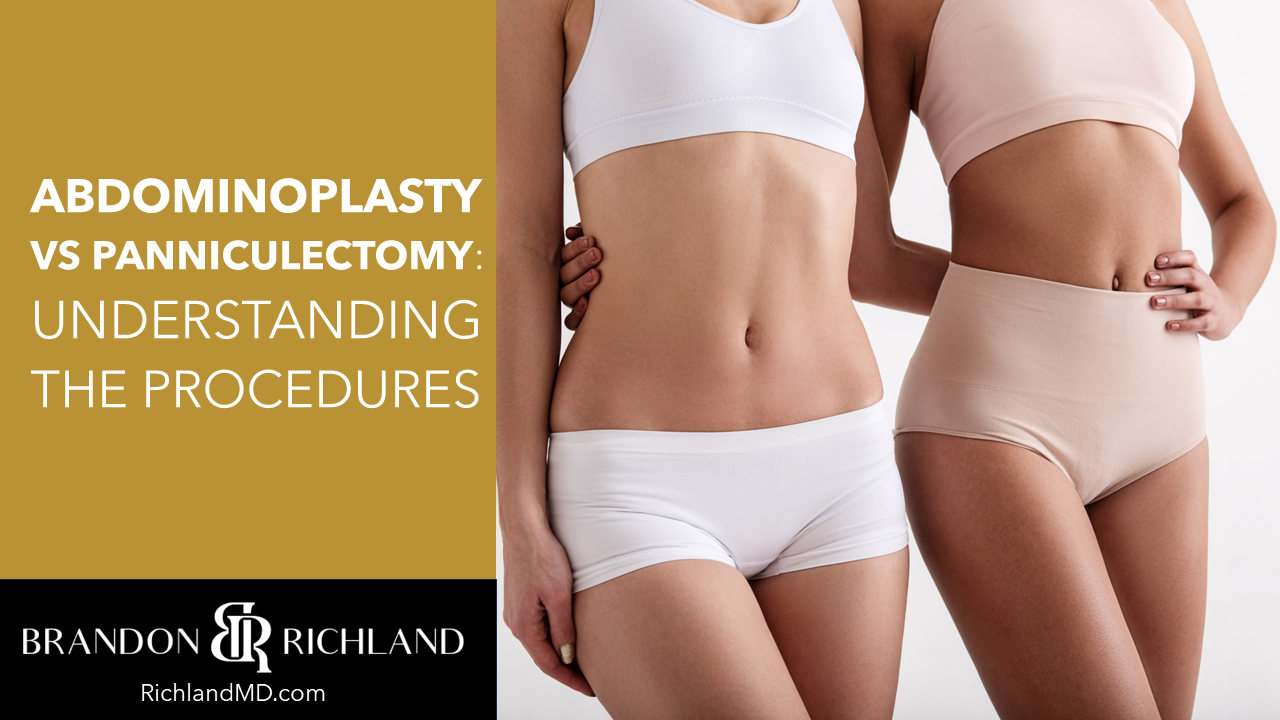Published by Dr. Brandon Richland, MD

Abdominoplasty, more known as tummy tuck, and panniculectomy are two different surgical options that target the abdomen.
Abdominoplasty is a cosmetic surgical procedure that improves body contour by removing excess skin and fat usually caused by pregnancy, while panniculectomy is a surgery to remove stretched out, excess fat and overhanging skin from the abdomen.
Key Takeaways of Abdominoplasty vs Panniculectomy
- Abdominoplasty is a surgical procedure that tightens the muscles in the abdomen and removes excess fat, skin, and tissue.
- Panniculectomy focuses on removing the pannus, or the overhanging apron of fat and skin in the lower abdomen usually caused by massive weight loss.
- Abdominoplasty is usually not covered by insurance, panniculectomy may be insurance covered under certain conditions.
- Typical recovery times are 4 weeks for tummy tuck procedures and 6 weeks for panniculectomies.
- Both procedures offer improvement in shape through body contouring along with potential health benefits such as back pain relief due to reduced stressors around the midsection area.
Understanding Abdominoplasty or Tummy Tuck
The surgery is designed to improve the shape of the abdomen by reducing bulging or sagging skin caused by pregnancy, age, heredity factors, and weight fluctuations.
Understanding an Abdominoplasty Procedure
During a tummy tuck procedure, the surgeon makes an incision along the lower abdominal wall in order to remove any excess tissue that may be distorting the body due to weak core muscles. Liposuction can be used during this process if necessary. After the removal of excess tissue and fat, the abdominal muscles are tightened and brought together to create a smoother aesthetic appearance.
Results of a tummy tuck are often seen immediately following recovery.
Removal of Excess Fat, Skin, and Tissue
In abdominoplasty the tightening of the underlying muscles in abdomen is often combined with the removal of excess fat, skin, and tissue from the abdomen.
A full abdominal wall reconstruction may be performed at the same time to further improve muscle tone if necessary. Patients experience some degree of swelling and discomfort during recovery. For many, this temporary annoyance is worth it for better body contour long term.
Understanding Panniculectomy
Panniculectomy is a surgical procedure to remove pannus, a condition where an overhanging apron of skin and fat develops after a massive weight loss.
Removal of Pannus
Panniculectomy is a surgical procedure used to remove the skin and fat tissue from the abdomen. This technique involves removing an area of overhanging skin, often referred to as a pannus or apron.
Differences Between Abdominoplasty and Panniculectomy
These two procedures target the same area of the body and remove excess fat, but differ in general purpose, surgical techniques, and recovery time.
Surgical Techniques
Abdominoplasty is a procedure which focuses on tightening muscles in the abdomen and removing excess fat, skin, and tissue to achieve a contoured abdomen. During the procedure, the plastic surgeon makes an incision to separate the underlying abdominal muscles from their surrounding environment, while also expelling any extra fat or tissues.
For optimal results, the underlying muscle layers are sutured back together to provide enhanced contouring of the waist without relying solely on removal of excess fats.
Panniculectomy differs from abdominoplasty as it specifically targets the lower mid portions of the abdomen, with limited scarring than a conventional tummy tuck.
Recovery Time
The recovery time for a standard tummy tuck is around four weeks, compared to panniculectomy surgery where the healing process usually takes up to six weeks.
Panniculectomies are longer surgeries as they involve more tissue removal. Bariatric surgery patients often opt for a panniculectomy rather than abdominoplasty if there has been significant weight loss afterward, sometimes within a six months period.
Like with any medical procedure, it is important to realize that achieving significant weight loss and maintaining this weight prior to any form of body contouring or sculpting will create better results and faster healing times in comparison with having an extreme weight loss just before a surgery.
Recovery and Results
Patients should expect a healing process that takes four to eight weeks for both procedures, with gradual improvements in results as the swelling and bruising subside.

Healing Process for Both Procedures
Following an abdominoplasty procedure, patients must allow a minimum of 4 to 6 weeks for recovery. This is to ensure the wounds heal correctly and adequately and swelling to subside.
During the recovery period, patients should follow post operative instructions from surgeons to prevent any complications or infections.
For panniculectomy procedures, similar outcomes can be expected but can take a longer amount of time, usually one or two years, before final results become noticeable. Swelling may take up to 3 months or longer after the initial surgery, depending on individual cases alongside how much pannus was removed in total.
Candidacy for Abdominoplasty
May consider abdominoplasty for the various body benefits it provides. This surgical procedure not only removes skin and tissue, but also tightens abdomen to provide a flatter, more toned abdomen.
It is effective for those with loose skin due to weight loss or pregnancy as well as individuals who have tried other measures such as diet and exercise without success. Post surgery, most patients experience an improvement in their silhouette of the midsection, which can significantly boost confidence and self-esteem.
The overall goal is to improve upon the unbalanced proportions of the core area in order to create a smoother waistline and flat stomach contour that they can be proud of.
Not Covered by Insurance
Many insurance carriers will not cover the cost of abdominoplasty, as this procedure is classified as cosmetic in nature and does not fulfill any necessary medical requirements. Any money spent on an abdominoplasty must come out of pocket from personal savings or credit lines.
A tummy tuck can range from $6,000 to $12,000 depending on factors including size of tissue to be removed and geographic location.
Candidacy for Panniculectomy
Panniculectomy is often performed when an individual has experienced a large amount of weight loss, such as after bariatric surgery. Diet and exercise may not be sufficient to remove these extra folds of fat and skin due to laxity of the muscles in the abdomen.
A panniculectomy can be a beneficial option which allows individuals to address this issue and achieve renewed aesthetic satisfaction through contouring the natural shape of their abdomen.
Often Covered by Insurance
Panniculectomy is a cosmetic procedure for removing excess hanging skin and scar tissue, such as occurring after massive weight loss. It may be covered by medical insurance in certain scenarios that are usually considered medically necessary, such as the presence of rashes or infection underneath the pannus.
Cost Considerations
Individuals may want to research and understand the possible expenses associated with each of these plastic surgery procedures, such as their potential out of pocket costs or insurance coverage for one over the other.

Expenses Associated With Each Procedure
A panniculectomy is often more expensive than a tummy tuck, with costs ranging from $8,000 to $15,000 depending on the surgeon’s expertise and qualifications.
A major factor that affects the price of both procedures is the amount of time spent in surgery. Other factors also contribute to the total cost such as anesthesia fees and hospital costs. Facilities such as surgical centers could further impact pricing.
Insurance Coverage
Insurance coverage varies depending on the patient’s insurer and health plan. Providers such as Blue Cross Blue Shield may potentially cover the cost of a panniculectomy after meeting specific criteria and guidelines.
Abdominoplasty on the other hand, are not commonly covered by insurance, but patients may opt for financial assistance programs specific for cosmetic surgeries.
Potential Side Effects
All surgeries come with potential risks and side effects during the procedure and recovery period.
Risks and Complications of Abdominoplasty
Tummy tuck surgery can lead to adverse reactions to the anesthesia such as low blood pressure or slow heart rate. Most common complications include scarring, hematoma, infection, and seroma.
Strategies for managing complications in abdominoplasty involve preventing and managing issues based on post-op care guidelines.
Risks and Complications of Panniculectomy
Panniculectomy carries potential risks and complications, including poor wound healing, fluid collection under the skin which may lead to infection. Rarely, individuals who undergo this procedure may experience significant pain and numbness because of nerve damage.
Choosing the Right Procedure
Consulting with a board certified plastic surgeon can help patients understand their options and goals to know which procedure is more suitable.
Consulting With a Board Certified Plastic Surgeon
A doctor consultation is an important step before choosing between an abdominoplasty and a panniculectomy, as patients are guided through the decision making process and ensure that their individual goals and needs are taken into account.
Considering Individual Goals and Needs
Abdominoplasty plastic surgery is performed under general anesthesia for individuals with excess skin, fat, and muscle laxity in the abdominal area, who are seeking tighter abdominal muscle as well as removal of excess fat and tissue.
Panniculectomy surgery, on the other hand, is commonly done after massive weight loss where a significant amount of excess skin or pannus has developed beyond the normal hip waist ratio. It focuses exclusively on removing the rolls of skin that hang from beneath one’s clothing and not necessarily tightening abdominal muscle, therefore it leaves out any liposuction or muscle repair.
If a person chooses panniculectomy over a tummy tuck but actually needs abdominoplasty, then they would be left unsatisfied because most likely this will not result in the outcome they initially expected.
Frequently Asked Questions About Abdominoplasty vs Panniculectomy
1. What is the Difference Between an Abdominoplasty and a Panniculectomy?
An abdominoplasty is a cosmetic procedure designed to remove excess skin and fat from the stomach area in order to tighten the abs and create a more flattering silhouette. A panniculectomy is similar but focuses solely on removing the large flap of tissue called pannus that hangs down below the waistline due to significant weight loss or pregnancy.
2. Who Should Consider Getting an Abdominoplasty?
Women who have a bulging belly due to multiple pregnancies, and those who do not show improvement around the stomach area from exercise and dieting due to lax abdominal muscles, are great candidates for abdominoplasty.
3. Who Should Consider Getting a Panniculectomy?
A panniculectomy can be beneficial for someone who has lost significant amounts of weight either through dieting and exercise or through bariatric surgery, and still has loose skin around their midsection that continues to cause discomfort even after stabilization of their bodyweight.

Conclusion and Summary of Abdominoplasty vs Panniculectomy: Understanding the Procedures
The right surgical option for treating excess abdominal skin depends on an individual’s needs and goals. Abdominoplasty is a popular choice among individuals looking to tighten their abdomen and remove excess fat, skin, and tissue in order to achieve improved body contours with a single procedure.
On the other hand, panniculectomy focuses solely on removing excess skin hanging from lower abdominal pannus after significant weight loss in order to improve both appearance as well as health issues such as rashes or ulcerations caused by rubbing of fabric against this large overlay of skin and fat.
Consulting with an experienced plastic surgeon who specializes in either type of surgery can help determine the most suitable option, while ensuring safety during recovery.
Please note that this article is intended for informational purposes only and should not be construed as medical advice. Before making any changes to your treatments, please consult with your healthcare provider to discuss the appropriateness and safety of such changes.
Ready For Your First-Class Cosmetic Experience in Orange County (OC) California (CA)?
Are you located in one of these Orange County (OC) / Southern California cities?
Aliso Viejo, Anaheim, Brea, Buena Park, Costa Mesa, Coto de Caza, Cypress, Dana Point, Fountain Valley, Fullerton, Garden Grove, Huntington Beach, Irvine, La Habra, La Palma, Laguna Beach, Laguna Hills, Laguna Niguel, Laguna Woods, Ladera Ranch, Lake Forest, Los Alamitos, Mission Viejo, Newport Beach, Orange, Placentia, Rancho Santa Margarita, San Clemente, San Juan Capistrano, Santa Ana, Seal Beach, Stanton, Tustin, Villa Park, Westminster, or Yorba Linda?
Plastic Surgeon Dr. Brandon Richland, MD and our Cosmetic Aesthetics Team are ready to help you look and feel your absolute best.
Elevate your confidence and self esteem levels to unfathomable new heights!
Schedule your in-person consultation in our modern and luxurious offices in either Fountain Valley, CA (Main HQ) or our Newport Beach, CA office.
Do you live outside of Southern California or short on time? For your convenience, Virtual Consultations are also available.
Our warm and engaging Team of carefully selected Aesthetics Professionals will make you feel calm, cool, collected, and right at home throughout your entire consultation and surgery process.
Schedule Your Aesthetics Consultation here, or call us directly at 949-867-4496 today.
About the Author

Dr. Brandon Richland, MD is a respected Board Certified Licensed Plastic Surgeon in Orange County / Southern California specializing in cosmetic and reconstructive surgeries.
Driven by his passion for medicine, Dr. Richland obtained his Doctor of Medicine (M.D.) degree from the prestigious program at Saint Louis University (SLU) School of Medicine in 2013. His exceptional skills were recognized when he received the McGraw Hill / Lange Medical Student Academic Achievement Award, and graduated top of his class with Honors. For his undergraduate degree, he attended University of California, Los Angeles (UCLA) and graduated with Honors in 2009.
To further enhance his surgical expertise, Dr. Richland completed his Residency in Plastic Surgery at the University of California, Irvine (UCI) from 2013 to 2019 earning the Academic Achievement Award twice during this period. A total of 14 years in dedicated schooling and medical residency.
Dr. Richland is actively involved with healthcare and medical societies, as a Diplomate of the American Board of Plastic Surgery, a member of the American Society of Plastic Surgeons, American Society of Aesthetic Plastic Surgeons, and the California Society of Plastic Surgeons.
Contact Dr. Richland today by visiting RichlandMD.com, scheduling a cosmetic consultation, or by calling 949-867-4496 directly.
Cover Image Credit: Iakovenko / 123RF.com (Licensed). Photo Illustration by: Dr. Brandon Richland, MD.










